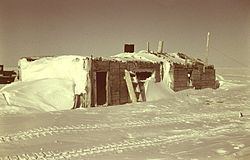Built 1906 Designated NHL June 2, 1978 Area 4 ha | NRHP Reference # 71001093 Opened 1906 Added to NRHP 21 June 1971 | |
 | ||
Location Flaxman Island, 58 mi. W of Barter Island on Arctic coast of Alaska Similar Alaska Native Brotherho, Cape Sarichef Light, Castle Hill, Church of the Holy Ascension, Fort William H Seward | ||
The Leffingwell Camp Site, on Flaxman Island, 58 miles (93 km) west of Barter Island on the Arctic Coast of Alaska, was used by polar explorer and geologist Ernest de Koven Leffingwell on his pioneering Anglo-American Polar Expedition of 1906–1908, which aimed to explore the Beaufort Sea. The expedition's ship, the Duchess of Bedford, was allowed to become locked in ice which eventually destroyed it.
Map of Flaxman Island, Alaska, USA
The camp site was chosen before the ship was locked in ice, and was not merely the nearest landfall. The site was used by Leffingwell over several years, beyond the end of that expedition.
Leffingwell created the first accurate map of a section of Alaskan coastline. He was the first to scientifically describe permafrost and to pose theories about permafrost which have largely proven true. He accurately identified the oil potential of the area, including assessing that it was not, in his day, technologically or economically feasible to develop it.
Following the destruction of the Duchess of Bedford, Leffingwell "returned to civilization in the fall of 1908, as the guest of Capt. George B. Leavitt." Leffingwell subsequently named Narwhal Island for the name of Capt. Leavitt's vessel, the steam New Bedford, Massachusetts-based whaler Narwhal, and bestowed the name of the Maine-born Captain, who married an Inuit woman and settled at Barrow, on Leavitt Island off the Alaska North Slope.
The historic integrity of the camp was diminished in the 1930s when some structure was removed by a salvager.
The camp was declared a National Historic Landmark in 1978.
